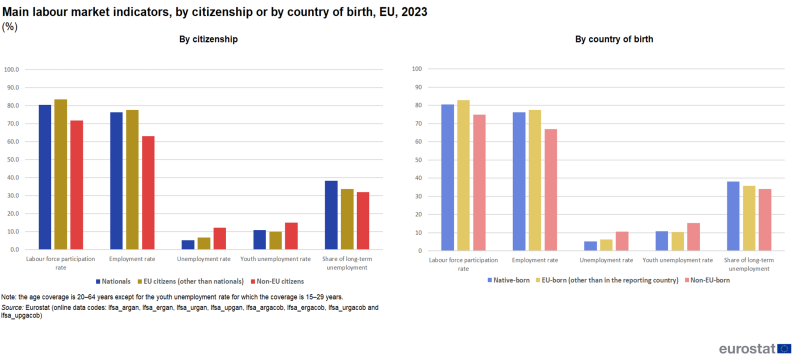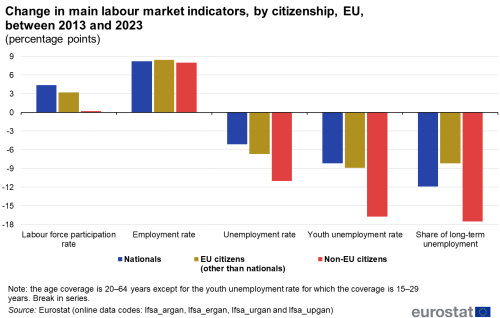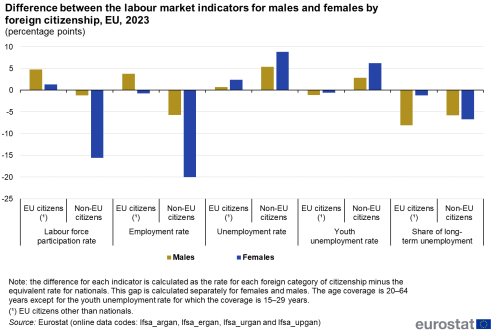Overview
The labour force survey (EU-LFS) is the source of data for this article. The main focus of this article is the age group 20–64 years. This age group is of particular interest as it is the focus for employment analyses in the Action Plan on Integration and Inclusion 2021–2027. The information for the youth unemployment rate refers to people aged 15–29 years.
Five labour market indicators are presented in this article: labour force participation rate, employment rate, unemployment rate, youth unemployment rate and the share of long-term unemployment.
- The labour force participation rate is the proportion of people in the labour force (employed or unemployed) as a percentage of the total population.
- The employment rate is the number of employed persons (someone working as an employee, self-employed or contributing family workers) as a percentage of the total population.
- The unemployment rate is the number of unemployed persons as a percentage of the labour force.
- The youth unemployment rate is the number of unemployed persons aged 15–29 years as a percentage of the labour force aged 15–29 years.
- The share of long-term unemployment is the number of long-term unemployed persons (unemployed for at least a year) as a percentage of all unemployed persons.
The overview focuses on an analysis of these five indicators by citizenship and by country of birth. The following five sections – one for each indicator – present information by citizenship only.
Among persons aged 20–64 years living in the EU in 2023, 80.5 % of nationals were part of the labour force, in other words employed or unemployed. This labour force participation rate was higher than for non-EU citizens (71.8 %) but lower than for citizens of other EU countries (83.4 %).
Among persons aged 20–64 years living in the EU in 2023, 76.2 % of nationals were employed (employees, self-employed or contributing family workers). Again, the employment rate was higher than for non-EU citizens (63.0 %) but lower than for citizens of other EU countries (77.6 %).
The unemployment rate among persons aged 20–64 years living in the EU in 2023 was 5.4 % for nationals. The rate was higher for citizens of other EU countries (6.9 %) and approximately twice as high, 12.2 %, for non-EU citizens.
The youth unemployment rate is calculated for persons aged 15–29 years. In 2023, this rate in the EU was 10.9 % for nationals, 10.0 % for citizens of other EU countries and 15.1 % for non-EU citizens. Compared with the unemployment rate among persons aged 20–64 years, the youth unemployment rate was 2.0 times as high for nationals, 1.4 times as high among citizens of other EU countries and 1.2 times as high for non-EU citizens.
Almost two out of five unemployed persons aged 20–64 years living in the EU in 2023 had been unemployed for at least one year. This share was lowest for unemployed non-EU citizens (31.9 %) and highest for unemployed national citizens (38.2 %), with the share for unemployed citizens of other EU countries (33.8 %) between these two.
When analysed by country of birth rather than by citizenship, similar patterns were observed.
Between 2013 and 2023, the labour force participation rate increased in the EU for all three categories of citizenship – see Figure 2. The increase in this rate was strongest among nationals (up 4.4 percentage points (pp)).
For the employment rate, increases were observed in the EU between 2013 and 2023 for all three categories of citizenship. Citizens of other EU countries recorded the largest increase (up 8.4 pp), while nationals recorded a bigger increase (up 8.2 pp) than non-EU citizens (up 8.0 pp).
For both unemployment rates – for persons aged 20–64 and 15–29 years – these decreases (in percentage points) were smallest for nationals and largest for non-EU citizens. For share of the long-term unemployment, the smallest decrease between 2013 and 2023 was observed for citizens of other EU countries.
For both categories of foreign citizenship, Figure 3 shows the difference between males and females. For each sex, this gap is calculated as the rate for each of the two foreign citizenship categories minus the rate for nationals.
For all five indicators, the difference between the rates in the EU in 2023 was widest for female non-EU citizens. For the labour force participation, employment, youth unemployment and long-term unemployment rates, the gap was narrowest for female citizens of other EU countries, while for the unemployment rate among persons aged 20–64 years it was narrowest for male citizens of other EU countries.
- The labour force participation rate for female non-EU citizens was 15.6 pp lower than for female nationals. This gap can be contrasted with a much lower gap of 1.2 pp for male non-EU citizens. The labour force participation rate was higher for citizens of other EU countries than for nationals of both sexes, but with a narrower difference observed for females than for males.
- The employment rate for female non-EU citizens was 20.0 pp lower than for female nationals. This gap can be contrasted with a gap of 5.7 pp for male non-EU citizens. The gap was narrower and in the opposite direction (3.8 pp) for male citizens of other EU countries, while for female citizens of other EU countries there was a gap of 0.7 pp between the rates with a higher rate for female nationals.
- The unemployment rate for female non-EU citizens was 8.8 pp higher than for female nationals. For male non-EU citizens this gap was 5.4 pp. The gaps were smaller for citizens of other EU countries than for non-EU citizens, with the narrowest gap observed for males.
- For the youth unemployment rate, the gaps for both male and female citizens of other EU countries were negative. The difference between the rates was narrower for females (0.6 pp) than males (1.1 pp). The youth unemployment rates for non-EU citizens of both sexes were higher than the rates for nationals and for other EU countries. The gap was wider for female non-EU citizens with 6.2 pp compared with a gap of 2.9 pp between male non-EU citizens and male nationals.
- The shares of long-term unemployed were highest among both female and male nationals. For citizens of other EU countries, the gap was wider for male citizens of other EU countries with 8.1 pp. For non-EU citizens, this gap was slightly wider for female non-EU citizens with 6.7 pp compared with a gap of 5.8 pp between male non-EU citizens and male nationals.
Labour force participation rate
The labour force participation rate is the number of people in the labour force as a percentage of the total population.
Among EU countries, the highest labour force participation rate in 2023 for nationals was in Sweden (88.6 %). This rate was above 75.0 % in the vast majority of EU countries. Lower rates were observed in Luxembourg, Romania and Italy where the lowest rate was recorded (71.5 %).
For citizens of other EU countries, there was a greater range of values between the EU countries (no data for Bulgaria or Romania) in 2023. Among EU countries with reliable data, the highest rate was observed in Sweden (92.0 %), while the lowest rate was in Greece (60.0 %). The range in rates was also broader for non-EU citizens than for nationals, from 91.1 % in Malta to 59.5 % in Belgium.
In 14 of the 21 EU countries for which reliable data are available, labour force participation rates in 2023 were higher for citizens of other EU countries than for nationals. The largest gap was for Luxembourg, where the rate for citizens of other EU countries was 9.7 pp higher than for nationals. The seven EU countries where lower labour force participation rates were recorded for citizens of other EU countries than for national citizens were Belgium, Germany, France, Latvia, Estonia, Hungary and Greece. In Greece, where the gap was the largest, the rate for citizens of other EU countries was 15.9 pp lower than that for nationals.
In 15 of the 25 EU countries for which data are available, labour force participation rates in 2023 were lower for non-EU citizens than for nationals. The largest gap was in Hungary, where the rate for non-EU citizen was 20.5 pp lower than for nationals. Among the 9 EU countries where non-EU citizens recorded higher labour force participation rates than nationals, the largest gaps were observed in Malta (10.3 pp). In Romania the shares recorded for non-EU citizens and for nationals were equal.
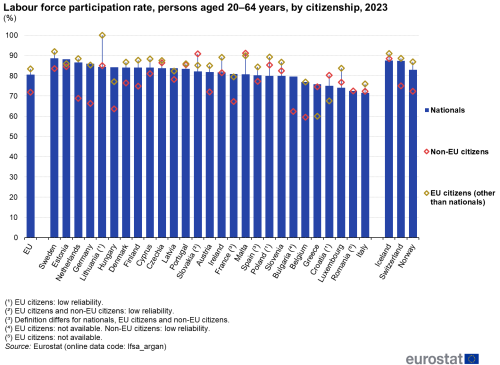
(%)
Source: Eurostat (lfsa_argan)
Employment rate
The employment rate is the number of employed persons as a percentage of the total population.
The highest employment rate in 2023 for nationals was in the Netherlands (84.3 %). The employment rate was above 70.0 % in the vast majority of EU countries. Lower rates were observed in Romania and Greece, with the lowest rate (66.4 %) in Italy.
For citizens of other EU countries, there was a much greater range between the EU countries (no data for Bulgaria and Romania) for employment rates in 2023. Among EU countries with reliable data, the highest rate was observed in Malta (87.6 %), while the rate was just below half in Greece (49.5 %). For non-EU citizens, the range in employment rates was also broader than for nationals, from 87.4 % in Malta to half (50.0 %) in Belgium.
In 12 of the 21 EU countries for which reliable data are available, employment rates in 2023 were higher for citizens of other EU countries than for nationals. The largest gaps were for Luxembourg and Malta, where the rates for citizens of other EU countries were respectively 9.2 and 8.7 pp higher than for nationals. Among nine EU countries where non-EU citizens recorded lower employment rates than nationals, the largest gaps were observed in Greece (18.2 pp) and Hungary (8.4 pp).
In 19 of the 25 EU countries for which reliable data are available, employment rates in 2023 were lower for non-EU citizens than for nationals; the largest gaps were recorded in Belgium (23.5 pp), Germany (22.9 pp) and the Netherlands (22.2 pp). Among the six EU countries where non-EU citizens recorded higher employment rates than nationals, the gaps were the largest in Malta and Croatia (8.5 and 7.8 pp).
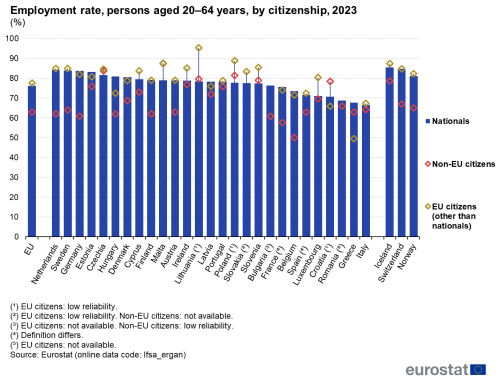
(%)
Source: Eurostat (lfsa_ergan)
Unemployment rate
The unemployment rate is the number of unemployed persons as a percentage of the labour force.
Among EU countries, the highest unemployment rates in 2023 for nationals were in Spain (10.9 %) and Greece (10.8 %). Elsewhere in the EU, this rate was below 8.0 %. The lowest rates were observed in Germany (2.4 %) and Malta (2.3 %).
For citizens of other EU countries, there was a much greater range between the EU countries (reliable data available for 12 Member States) for unemployment rates in 2023. The highest rates were in Spain (14.1 %) and Italy (11.3 %). At the other end of the ranking, the lowest recorded rates were 4.0 % in the Netherlands and 3.9 % in Germany.
In 2023, the range between the unemployment rates in EU countries for non-EU citizens (reliable data available for 18 Member States) was also broader than for nationals. The highest rate was 23.4 % in Sweden, 20.4 pp above the rate in Czechia (3.0 %) for which the lowest rate was observed.
In 10 of the 12 EU countries for which reliable data are available, unemployment rates in 2023 were higher for citizens of other EU countries than for nationals. The largest gap was for Denmark, where the rate for citizens of other EU countries was 4.9 pp higher than for nationals. The two EU countries where citizens of other EU countries recorded lower unemployment rates than national citizens were Luxembourg and Cyprus, where the gaps were narrow (at most 0.3 pp).
In all 18 EU countries for which reliable data are available, unemployment rates in 2023 were higher for non-EU citizens than for nationals. The largest gaps were in Sweden, Belgium and Finland, where the rates for non-EU citizens were, respectively, 18.1, 11.3 and 11.2 pp higher than for nationals. The narrowest gaps were in Czechia and Latvia, 0.5 and 1.4 pp, respectively.

(%)
Source: Eurostat (lfsa_urgan)
Youth unemployment rate
The youth unemployment rate is the number of unemployed persons aged 15–29 years as a percentage of the labour force aged 15–29 years.
Among EU countries, the highest youth unemployment rates in 2023 for nationals were in Greece (21.8 %) and Spain (20.9 %). The rate was below 20 % in the remaining EU countries. The lowest rates were observed in Czechia (5.4 %) and Germany (4.3 %).
Data for citizens of other EU countries and for non-EU citizens are only available for some EU countries, 7 and 12, respectively. For citizens of other EU countries, the range between the countries’ youth unemployment rates in 2023 was a little narrower than that for nationals, from 5.5 % in Germany to 20.2 % in Spain. Also for non-EU citizens, Germany had the lowest rate (9.7 %) while Sweden had the highest rate (24.5 %).
In five of the 7 EU countries for which reliable data are available, youth unemployment rates in 2023 were higher for citizens of other EU countries than for nationals. The largest gap was for Austria, where the rate for citizens of other EU countries was 4.1 pp higher than for nationals. In two EU countries, youth unemployment rates were lower for citizens of other EU countries than for nationals (Spain and France).
In 11 of the 12 EU countries for which reliable data are available, youth unemployment rates in 2023 were higher for non-EU citizens than for nationals. The largest gap was again in Austria, where the rate for non-EU citizens was 11.5 pp higher than for nationals. Only Italy recorded no gap between the youth unemployment rate for non-EU citizens and nationals, both of which were 16.7 %.

(%)
Source: Eurostat (lfsa_urgan)
Long-term unemployment
The share of long-term unemployment is the number of long-term unemployed persons (unemployed for at least a year) as a percentage of all unemployed persons.
Among EU countries with reliable available data, the highest shares of the long-term unemployed nationals in 2023 were recorded in Slovakia (66.9 %), Italy (58.7 %) and Greece (58.1 %). This share was below 25 % in only four EU countries. The lowest rates were observed in Austria (22.3 %), Estonia (20.1 %), the Netherlands (17.1 %) and Denmark (11.7 %).
Reliable data for citizens of other EU countries and for non-EU citizens are only available for some EU countries, 6 and 11, respectively. For citizens of other EU countries, the range of the countries’ shares of the long-term unemployed in 2023 was a little narrower than that of nationals, ranging from 22.3 % in France to 56.5 % in Italy. For non-EU citizens, the Netherlands had the lowest share (18.2 %) while Belgium had the highest share (50.4 %) of long-term unemployed persons.
In four of the 6 EU countries for which reliable data are available, the shares of long-term unemployment in 2023 were lower among citizens of other EU countries than among nationals. The largest gap of 8.4 pp was observed for Germany. In two EU countries, citizens of other EU countries recorded higher share than nationals (Belgium and Austria).
In seven of the 11 EU countries for which reliable data are available, the shares of long-term unemployment in 2023 were higher for non-EU citizens than for nationals. The largest gaps were recorded in Cyprus and Sweden, where the shares for non-EU citizens were 11.3 and 10.6 pp higher than those for nationals. Out of the four EU countries that recorded lower shares for non-EU citizens than for nationals, the largest gap was recorded in Italy with 12.1 pp.
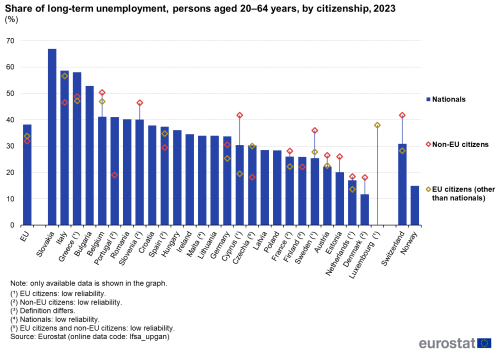
(%)
Source: Eurostat (lfsa_urgan)
Source data for tables and graphs
Data sources
The data presented in this article are from the labour force survey (LFS), the largest household sample survey in the EU. The survey covers the resident population, defined as all people usually residing in private households. As such, persons living in collective households are excluded from the target population. Usual residence means the place where a person normally spends the daily period of rest, regardless of temporary absences for purposes of recreation, holidays, visits to friends and relatives, business, medical treatment or religious pilgrimage. The data for the EU are aggregated results for the 27 Member States. For more information on the data sources used, please consult the online publication EU labour force survey.
Due to the sampling nature of the survey, some data have low reliability or are not published due to very low reliability or confidentiality. Data that are of low reliability are duly marked in the footnotes below the figures and tables.
Main concepts
The economically active population is also referred to as the labour force. It comprises employed and unemployed persons.
- An employed person is someone aged 15–89 years who, during the reference week of the labour force survey, performed work – even if just for one hour a week – for pay, profit or family gain. Also included are people who were not at work but had a job or business from which they were temporarily absent due to illness, holiday, industrial dispute or education and training.
- An unemployed person is defined by Eurostat, according to the guidelines of the International Labour Organization, as someone:
- aged 15 to 74 years,
- not employed during the reference week according to the definition of employment,
- currently available for work,
- actively seeking work or found a job to start within a period of at most three months.
- A long-term unemployed person is someone who is out of work and has been actively seeking employment for at least a year. The unemployment period is defined as the duration of a job search, or as the length of time since the last job was held (if shorter than the time spent on a job search).
Country notes
Spain and France have assessed the attachment to the job and included in employment those who, in their reference week, had an unknown duration of absence but expected to return to the same job once health measures allow it.
Calculation of key rates:
- the labour force participation rate is the number of people in the labour force (employed or unemployed) as a percentage of the total population;
- the employment rate is the number of employed persons as a percentage of the total population;
- the unemployment rate is the number of unemployed persons as a percentage of the labour force;
- the youth unemployment rate is the number of unemployed persons aged 15–29 years as a percentage of the labour force aged 15–29 years;
- the share of long-term unemployment is the number of long-term unemployed persons as a percentage of all unemployed persons.
Context
In November 2020, an Action Plan on Integration and Inclusion 2021–2027 (COM(2016) 377 final) was adopted with the purpose of fostering social cohesion and building inclusive societies for all. Inclusion for all is about ensuring that all policies are accessible to and work for everyone, including migrants and EU citizens with migrant background. This plan includes actions in four sectoral areas (education and training, employment and skills, health and housing) as well as actions supporting effective integration and inclusion in all sectoral areas at the EU, Member State and regional level, with a specific attention paid to young people.
More information on the policies and legislation in force in this area can be found in an introductory article on migrant integration statistics.

